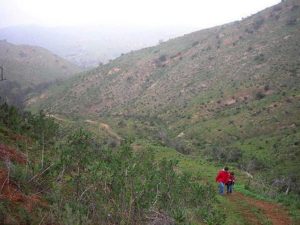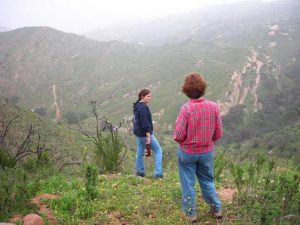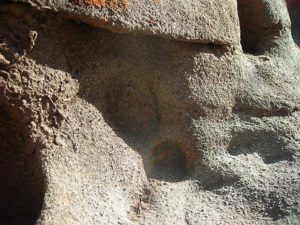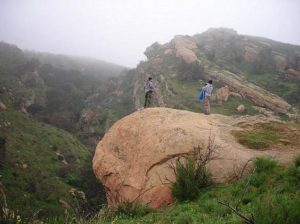
2. BBC (BBI) 2014 Summer Testing Results, September 2014
http://aboutus.aju.edu/uploadedFiles/Updates1/BBC_BCI_2014_Summer_Testing_Results_September_2014.pdf
3 pp
[ER NOTE: Old well campsite NOT tested for tritium in the water after shocking 2006 discovery.]
P. 1/3
“Groundwater near the southwest property line has a history of tritium contamination, but that has been decreasing over time.”
[ER NOTE: Report has highlighting on it suggesting AJU carefully inspected report, meaning they may have missed the continuing “tritium contamination” through lack of scientific acumen or deliberately ignored it.]
P. 1-2/3
“Citrus from the Main House orchard was tested for tritium. The level measured (22 pCi L) is consistent with natural levels measured in rainwater in years past.” [AJU HIGHLIGHTING]
[ER NOTE: WAIT A MINUTE! 2013 Cehn report says “Rainwater contains natural tritium, which is created in the upper atmosphere. Some of this water will eventually reach the groundwater aquifer. But the very long residence time in the aquifer results in the complete depletion of natural tritium via radioactive decay.” That means SSFL tritium may have made it to center of camp, according to Cehn’s own logic! Main house orchard is lemons.]
P. 2/3
“Tritium in Groundwater
Tritium is the most mobile of the radioactive elements found at Boeing. It has been found in groundwater and vegetation near the property line. Testing is done to gauge its movement groundwater, which is toward BBC. Water was collected from three flowing springs. I attempted to collect water transpired from plants closer to the property line.
However, this was unsuccessful, likely due to the drought and the lowered water table. In the past, this has been an efficient way to collect groundwater, without the need for a drilled well. But this year, no water could be collected from plant transpiration.”
[ER NOTE: Cehn is speaking accurately here.]
P. 2/3
“Results show near zero levels of tritium in the springs at the southwest corner of the property (Table 2).[ORIGINAL HIGHLIGHTING] In 1995, levels were as high as 520 picocuries per liter of water (pCi/L) in this area. The drop may be due to groundwater movement being affected by the drought. It may simply be due to a decrease via natural processes such as dispersion. I measured 25 pCi/L in this area in 2007. Note that groundwater typically has no tritium content, as opposed to surface water.[ER HIGHLIGHTING] Natural tritium is created by cosmic rays in the upper atmosphere.”.
[ER NOTE: By presumably AJU highlighting this, it shows they paid special attention to tritium and therefore knew it had been in its groundwater for years flowing out at the surface.]
P. 2/3
“CONCLUSIONS AND RECOMMENDATIONS
“The only change observed in this summer’s testing is a drop in the levels of tritium in groundwater. Tritium was released by Boeing decades ago and levels have been slowly decreasing. We should re-test groundwater after the drought is over, to see if contamination returns.”
[ER NOTE: Tritium DOES return when the rains return.]
P. 3/3: Shows everything tested but not one number.
[ER NOTE: Useless and concealing.]

3. Testing of New Wells at BBC, December 2013
http://aboutus.aju.edu/uploadedFiles/Updates1/Testing_of_New_Wells_at_BBC_December_2013.pdf
5 pp
[ER NOTE: Old well campsite NOT tested for tritium in the water after 2006 discovery.]
P. 1-2/5
“SUMMARY OF TESTING RESULTS
Tritium in Groundwater
Tritium is the most mobile of the radioactive elements found at Boeing. It has been found in groundwater and vegetation near the property line. Testing is done to gauge its movement in groundwater, which is toward BBC. Results show possible elevated tritium in one of the new wells in the south-central region of the property (New Wcll SP-424A). The level measured is 12 picocuries per liter of water (pCi/L). This compares to 19 pCi/L measured from a well in the southwest region two years ago. However, the value is rather close to the laboratory’s limit of detection (9.7 pCi/L), and may be a statistical artifact (false positive). It may also be due to natural tritium in the atmosphere that has infiltrated this shallow (8 ft.) well.(1) I plan to compare my results on this well with Boeing’s, when they become available.
“In any event, the measured levels are safe; they are well below the drinking water limit (20,000 pCi/L). [AJU HIGHLIGHTING] Results are shown in Table 1. The tap water result may or may not indicate the presence of tritium. If present, it is due to natural, atmospheric tritium. [ER HIGHLIGHTING] The lab report is attached as an appendix.”
FOOTNOTE (1): “1 Rainwater contains natural tritium, which is created in the upper atmosphere. Some of this water will eventually reach the groundwater aquifer. But the very long residence time in the aquifer results in the complete depletion of natural tritium via radioactive decay.”
[ER NOTE: WOW! Tritium in SP-424A in south-central BBI! And “tap water result may or may not indicate the presence of tritium. If present, it is due to natural, atmospheric tritium” is unclear and false but will reveal itself as this examination continues. And Cehn contradicts himself in Footnote 1 saying tap water got tritium from rain. Suggests orchard is sucking up groundwater with SSFL tritium in it as the rain is not the source by Cehn’s own words analyzed herein.]

P. 3/5
SP-424A 131104 (Nov 4, 2013) 12.9 ± 9.7 pCi/L
< 9.7 = less than 9.7, which is the lab’s detection limit
A, B, & C refer to separate wells in the cluster-A is the shallowest, C the deepest.
[ER NOTE: Tritium wasn’t the only troubling toxin found in SP-424A, B & C. And as Cehn suggested, Boeing was doing the testing so the results would come along. Perhaps Cehn and AJU missed this report. DTSC did.]
P. 5/5: Poorly displayed map shows where “New Well SP-424” is located on BB property off Area IV.

4. BBC (BBI) New Wells Testing Results, January 2012
http://aboutus.aju.edu/uploadedFiles/Updates1/BBC_BCI_New_Wells_Testing_Results_January_2012.pdf
3 pp
[ER NOTE: Old well campsite NOT tested for tritium in the water after 2006 discovery.]
P. 1/3
SUMMARY OF TESTING RESULTS
Tritium in Groundwater .
Tritium is the most mobile of the radioactive elements found at Boeing. It has been found in groundwater and vegetation near the property line. Testing is done to gauge its movement in groundwater, which is toward BBC. Results show elevated tritium in one of the new wells in the southwest comer of the property (see map, Figure 1, location: “New Well S19”). The level measured is 19 picocuries per liter of water (pCi/L) This compares to 69 pCi/L measured from a spring in this same area in 1995. The reduction over this period is consistent with test data from Boeing’ property. The drop is due to two factors radioactive decay of tritium and dispersion and dilution of tritium in the groundwater. The measured levels a.re safe; they are well below the drinking water limit 20,000 pCi/ L. [ORIGINAL AJU HIGHLIGHTING]
[ER NOTE: By highlighting this, AJU not only acknowledges reading it but also tries to have it both ways: Claiming no SSFL contamination offsite and that this contamination is actually a good sign in its decay, instead of noting it for what it is – continuing SSFL tritium release in a Brandeis-Bardin spring.]
P. 2/3: “The new wells vary in distance to the property line, from 700 feet to one-half mile.”












Recent Comments